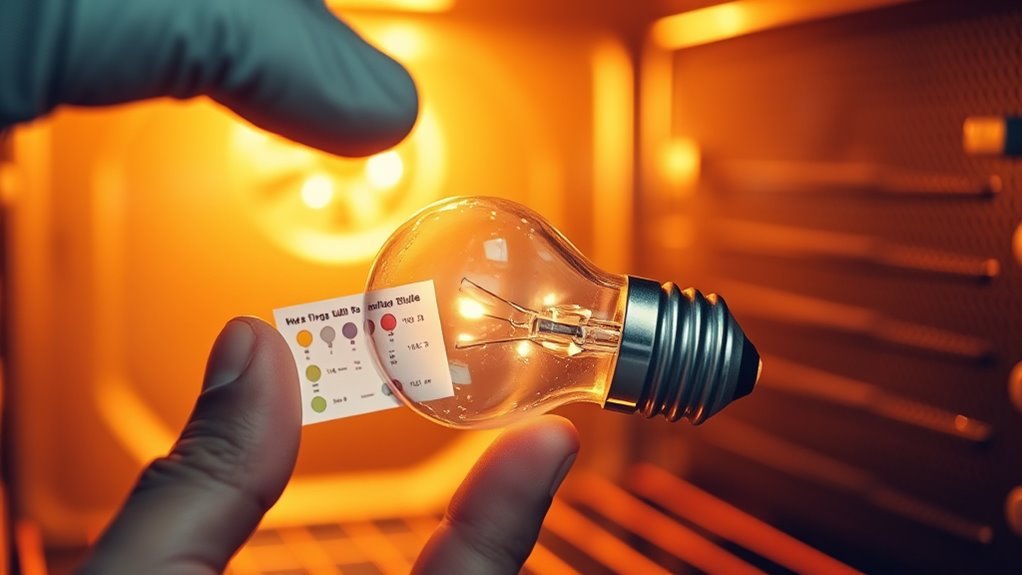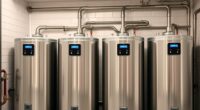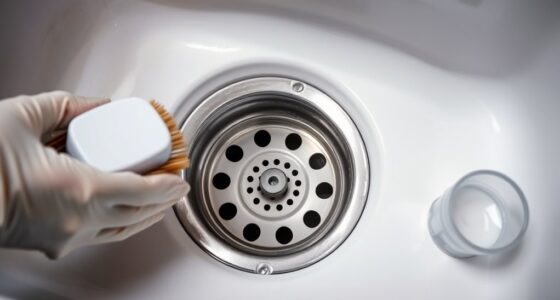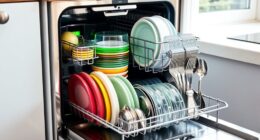When replacing your oven light, choose a bulb rated for high heat, typically incandescent or halogen, with a base like E26 or E12 that fits your fixture. Pay attention to wattage (usually 15-40W) and lumens for brightness, and pick a color temperature around 4000K-5000K for clear visibility. Make sure the bulb’s materials resist thermal shock and fit securely. If you keep exploring, you’ll find tips to select the best bulb for your oven’s needs.
Key Takeaways
- Select heat-resistant bulbs rated for 300°F to 500°F, such as incandescent, halogen, or LED options.
- Confirm the bulb base type (E26, E27, E12) and size to ensure proper fit in your oven.
- Check wattage and lumen output; aim for 20-50 lumens for adequate interior lighting.
- Consider color temperature (2700K-5000K) for optimal visibility and accurate color rendering inside the oven.
- Use bulbs with durable materials resistant to thermal cycling, oxidation, and shock for safety and longevity.
Types of Oven Light Bulbs and Their Features

Are you aware of the different types of oven light bulbs available and what makes each unique? Most ovens use incandescent bulbs rated between 40 and 50 watts, designed to withstand high heat. These appliance bulbs feature rugged filaments and heat-resistant glass, making them more durable than regular household bulbs. They typically have medium screw bases like E26 or E27, with some smaller models using candelabra bases such as E12. To endure the oven’s extreme temperatures and vibrations, many bulbs are coated or made from quartz glass. Their compact size allows them to fit into confined fixtures securely. The primary goal is to provide reliable, bright illumination while resisting heat damage. Understanding bulb ratings and specifications helps ensure proper performance and safety. Additionally, advancements in heat-resistant materials have further improved the durability of oven bulbs over time, especially with the development of quartz glass which can withstand even higher temperatures.
Understanding Wattage and Energy Efficiency in Oven Bulbs
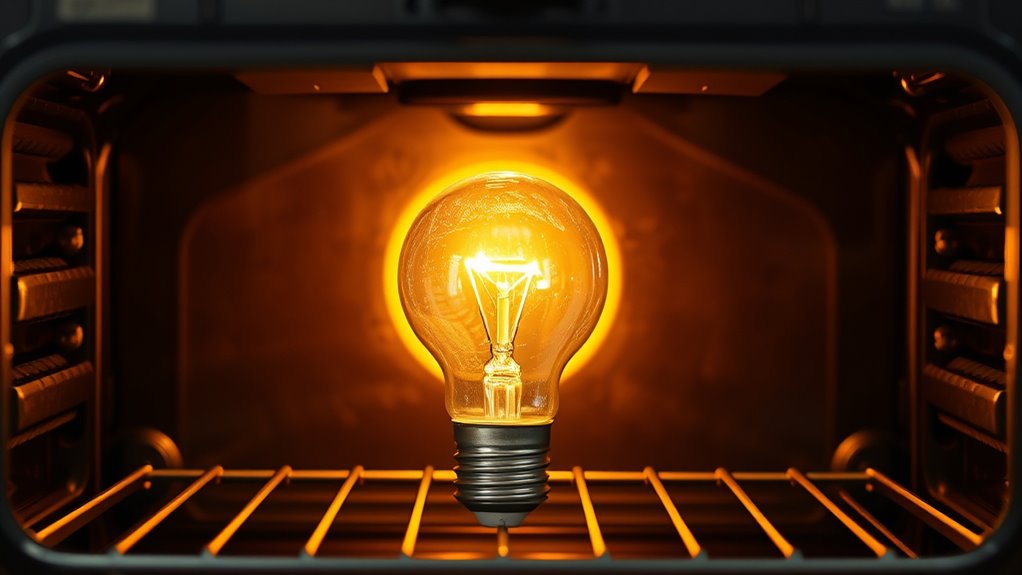
Understanding wattage helps you choose the right oven bulb without risking damage or inefficiency. While higher wattage bulbs are brighter, they also consume more energy and generate more heat, which can shorten bulb life. By comparing wattage and lumens, you can find a balance that offers good visibility while saving energy. A properly rated bulb ensures optimal performance and safety in your oven. Switching to LED bulbs not only reduces energy consumption but also minimizes heat output, making your oven safer and more efficient.
Energy Consumption Differences
Ever wondered how much energy your oven light consumes and how it compares to other household bulbs? The wattage of oven bulbs varies, impacting energy use and efficiency. Consider these points:
- Standard halogen or incandescent oven bulbs typically use around 40-60W, converting much of that energy into heat.
- LED replacements, though more energy-efficient at 7-10W, aren’t suitable for ovens due to heat sensitivity.
- A 40W oven bulb consumes approximately 0.029 kWh per hour, adding up over time.
- While LEDs save energy, the heat-resistant materials in oven bulbs cause them to be less efficient, with a significant portion of energy wasted as heat.
- The contrast ratio of the bulb can influence how clearly the light illuminates the oven interior under various conditions.
- Understanding the energy consumption of your oven bulb can help you make more informed choices about replacements and usage.
Your choice affects both energy consumption and safety, making it essential to understand these differences.
Wattage and Brightness
Wattage indicates how much electrical energy a bulb consumes, but it doesn’t directly measure how bright the light appears. Instead, brightness is measured in lumens, which show the actual light output. For oven bulbs, typical wattages range from 15 to 40 watts, aligning with the need for durability and heat resistance. Modern LED bulbs provide similar lumens as higher-wattage incandescent bulbs but use much less power, often around 4-7 watts. Choosing the right wattage helps verify your oven light is bright enough without risking overheating or damaging the fixture. Proper wattage ratings also guarantee compatibility with your oven’s electrical system. By matching wattage with brightness needs, you optimize energy efficiency and bulb longevity, ensuring consistent oven illumination. Additionally, understanding lighting efficiency can help you select bulbs that offer maximum brightness with minimal energy use. Recognizing bulb ratings ensures you select the most suitable options for safe and effective oven lighting.
Brightness and Light Output: What Lumens Mean for Your Oven
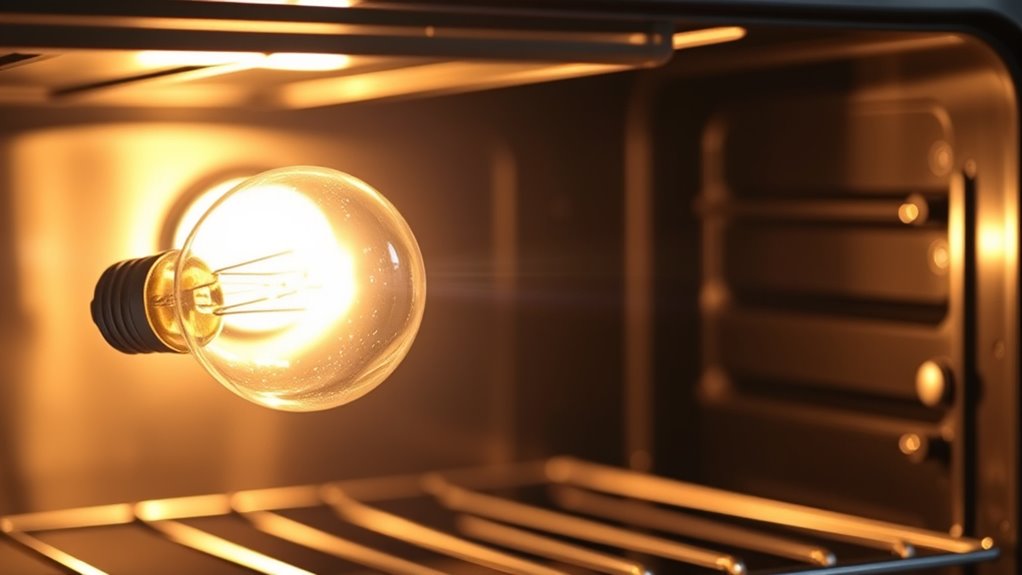
Understanding lumens helps you choose the right bulb for clear oven visibility without harsh glare. The right light level depends on your oven size and interior, balancing brightness and comfort. Selecting a bulb with the appropriate lumen output guarantees safe, effective cooking and easy food monitoring. Using the right lighting specifications ensures optimal performance and safety during cooking. Additionally, considering the projector technology used in different bulbs can improve the overall lighting quality and lifespan, making your choice more efficient.
Lumens and Visibility
Lumens measure the total amount of visible light a bulb emits, directly indicating how bright it will appear inside your oven. Understanding lumens helps you choose the right bulb for clear visibility without excessive heat or glare. Here are key points to take into account:
- Higher lumens mean a brighter light, improving your ability to see food clearly.
- Oven bulbs typically emit under 100 lumens, adequate for confined spaces.
- Balancing lumens ensures visibility without distorting color perception or causing heat issues.
- Factors like reflectivity, beam angle, and bulb placement influence how effectively light illuminates the interior.
- Recognizing appliance design traits can help you select solutions that minimize manipulation or frustration.
Brightness Standards for Ovens
Knowing the typical brightness levels of oven bulbs helps you select the right light for your appliance. Most oven bulbs produce between 20 and 50 lumens, which is enough for standard ovens. Brightness requirements depend on oven size and depth—smaller ovens need fewer lumens, while larger or deeper models may require more. Specialized bulbs like halogen or LED can deliver higher lumens for better visibility. Remember, wattage indicates power consumption, but lumens measure brightness. LEDs are popular because they offer energy efficiency and longer lifespans, making them ideal for oven lighting. Additionally, selecting a bulb with the correct lumens ensures optimal illumination and safety during cooking. Ensuring your bulb meets brightness standards helps you see clearly inside the oven, making cooking safer and more convenient. Proper bulb selection also supports efficient heating and optimal performance of your appliance. Always select a bulb with appropriate lumen output based on your oven’s size and your visibility needs.
Selecting Suitable Light Levels
Choosing the right brightness level for your oven light depends on balancing visibility with safety. To guarantee proper illumination, consider these factors:
- Oven size: Larger ovens need higher lumens for even lighting.
- Bulb type: LEDs provide more lumens at lower wattage, making them efficient.
- Reflective surfaces: They can amplify light, reducing the need for higher lumens.
- Task needs: Typical oven lighting ranges from 300 to 800 lumens; too low hampers visibility, too high causes glare.
Aim for a bulb emitting around 300-800 lumens for clear, safe monitoring without harshness. Selecting the appropriate brightness prevents under- or over-illumination, ensuring safe and effective cooking.
Heat Resistance and Durability of Oven Light Bulbs
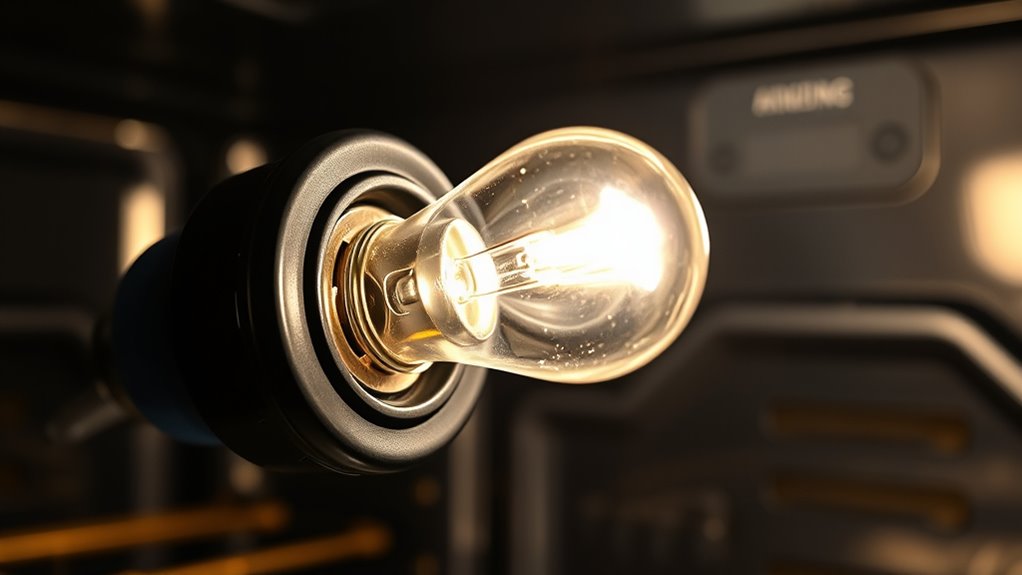
Oven light bulbs must withstand extreme heat conditions, which makes their heat resistance and durability critical for reliable performance. Typically, oven bulbs endure temperatures between 300°F and 500°F, with higher-rated bulbs lasting longer and performing better under heat. Halogen bulbs handle temperatures around 300°C (572°F), making them ideal for high-heat environments, while incandescent bulbs are designed to withstand up to 500°F (260°C). They use heat-resistant glass, durable filaments, and strong seals to survive thermal cycling and prevent cracking or failure. These materials resist oxidation and thermal shock from door openings and preheating. Properly rated bulbs maintain brightness longer and ensure consistent illumination, reducing replacement frequency. Their construction ensures reliable operation despite the intense, repeated heat exposure inside your oven. Understanding oven light bulb ratings helps in selecting the most suitable bulb for durability and safety, especially considering the heat resistance and durability requirements for long-lasting performance.
Matching the Correct Bulb Base and Fit for Your Oven

Matching the correct bulb base and fit is essential to guarantee your replacement light works safely and effectively. To do this, you should consider these key points:
- Identify the base type—common options include E26, E27, E12, and E17, with E26 and E17 being typical for ovens.
- Measure the base diameter—use a ruler or check packaging to confirm the size matches your socket.
- Check the bulb shape and size—ensure the length and width fit within the oven’s light housing without touching elements.
- Verify electrical ratings—match voltage (120V or 240V) and wattage to avoid overheating or contact issues.
- Understand the importance of proper socket compatibility—using the correct affiliate disclosure and ensuring your bulb matches the socket specifications will help maintain safety and performance.
Choosing the Right Color Temperature for Optimal Visibility
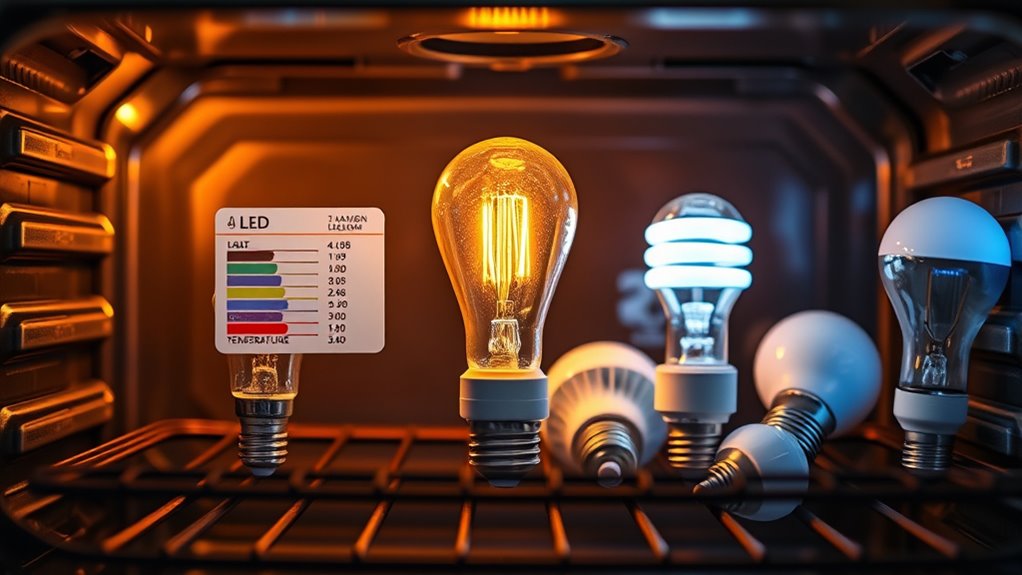
Selecting the right color temperature for your oven light is essential because it directly affects how well you see food and interior details. Warm light (2700K-3000K) creates a cozy glow but may obscure fine details, making it harder to judge doneness. Cool light (3500K-5000K), especially in the 4500K-5000K range, produces a bright, daylight-like illumination that enhances clarity and color accuracy, ideal for food inspection and precise cooking. Higher Kelvin bulbs emit whiter, brighter light, improving visibility and reducing eye strain during extended use. Color rendering index (CRI) plays a crucial role in how accurately colors appear under different lighting temperatures, helping you make better visual assessments. Avoid overly warm bulbs below 3000K, as they can distort colors and hinder your ability to assess food quality. For ideal visibility, choose bulbs in the 4000K to 5000K range to see textures, browning, and details clearly. Additionally, selecting bulbs with appropriate halal certifications ensures the safety and compliance of your lighting choices if you are mindful of dietary laws.
Frequently Asked Questions
Can I Replace My Oven Bulb With Any LED Bulb?
No, you shouldn’t substitute your oven bulb with just any LED bulb. Most standard LED bulbs aren’t designed to withstand the high temperatures inside an oven, which can cause them to fail or pose safety risks. Instead, look for LED bulbs specifically rated for oven use, with heat-resistant features and proper base fittings like E14 or G9. Always check your oven’s manual for recommended bulb types to ensure safety and compatibility.
How Do I Know if a Bulb Is Oven Safe?
Did you know oven bulbs are designed to withstand temperatures up to 300°C? To know if a bulb is oven safe, check the packaging for heat resistance ratings or labels like “appliance bulb” or “oven bulb.” Confirm it’s rated for high temperatures, typically 300°C or more. Also, verify the base type matches your oven’s socket and avoid LED or CFL options. Trust reputable brands for safety and durability.
Will a Higher Lumen Bulb Improve Oven Interior Lighting?
Yes, a higher lumen bulb can enhance your oven’s interior illumination by making it brighter and easier to see inside. However, you need to make certain the bulb’s wattage and type are compatible with your oven’s specifications. Using a bulb with considerably more lumens than recommended might risk overheating or damaging the oven. Always choose a bulb rated for high temperatures and approved for oven use for safety and ideal lighting.
Are G9 Base Bulbs Compatible With All Oven Models?
You can’t assume G9 base bulbs work with all oven models. Each oven has its own specifications, and compatibility depends on heat resistance, wattage, and socket design. Check your oven’s manual or manufacturer’s recommendations before swapping bulbs. Using the wrong type is like putting a square peg in a round hole—you’re risking damage or safety hazards. Stick to the approved G9 bulbs to keep things running smoothly and safely.
How Do I Prevent Bulb Shattering During Replacement?
To prevent bulb shattering during replacement, make sure the oven is completely cool before handling the bulb. Wear gloves or use a cloth to avoid skin oils, which can cause hot spots and cracks. Handle the bulb gently, avoiding excessive force when installing or removing it. Use the correct wattage and type rated for high temperatures. Carefully remove the cover without applying too much pressure, and ensure everything is secure without overtightening.
Conclusion
Now that you know the key factors in choosing the perfect oven light bulb, you’re almost ready to upgrade. But what if your current bulb isn’t compatible or lasts just a few months? The right choice can make all the difference, ensuring safety, brightness, and durability. Are you prepared to pick the perfect bulb that’ll keep your oven well-lit and your cooking seamless? The next step could change your baking game forever—are you ready to discover it?
